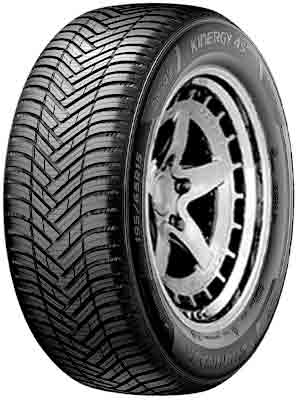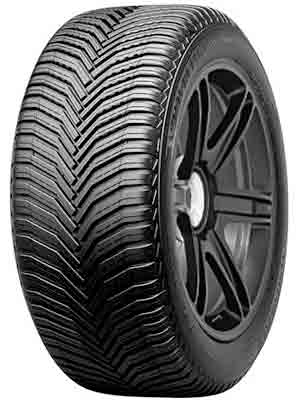Both these tires are a part of the grand touring all-season tire category, which are engineered to provide a smooth ride and dependable all-season traction, as well as more responsive handling. 4S2 has a larger void ratio and efficient sipes, which are excellent for wet traction, as well as for reducing the threat of hydroplaning.
CrossClimate 2, on the other hand, features a reduced void ratio, which ensures good grip in dry situations, and its broad shoulders ensure accurate steering.

In this article, we compare the performance of two similar V-shaped tread design tires to decide who is better in which category.
Table of Contents
Comparing Tread Pattern of both tires:
Hankook Kinergy 4s2

Michelin Crossclimate 2

The Hankook Kinergy 4S2’s V-shaped tread pattern is purposefully developed to combine complementing technologies to give traction and performance in any season.
Tread noise is reduced and biting edges are increased for adverse weather grip by enhancing and optimizing the tread pattern’s pitch count and variety.
Wide, lateral tread blocks offer an area for grip during steering while broad lateral grooves are also used as water escape accelerators Summer sipes with a high density are inserted across the tread blocks to help give traction in wet conditions while still maintaining a strong connection to the road and handling accuracy.
Concave tie-bars and two-step aqua slant improve tread block stability while maintaining empty room for optimum hydroplaning resistance.
CrossClimate’s V-Formation directional tread design is optimized for dry, wet, and winter conditions. It used Noise Reduction Tuning, which uses sophisticated tread pattern modeling to assist tune out airborne noise by varying tread element shape and timing.
The central region of the tread promotes longitudinal dry grip by aligning blocks with front and rear forces, resulting in more consistent block area engagement when advancing or halting.
V Ramp chamfers carved into the ends of the blocks enhance contact with the ground under load, further improving braking traction.
The shoulder blocks start to line horizontally with the tread as they go more outboard, helping to boost turning forces and control.
The tread’s 3D SipeLock technology promotes block stiffness for assured handling while also enhancing traction in wet conditions. Without the use of circumferential grooves, the sharp angles in the tread pattern assist drain moisture away from the contact area, boosting hydroplaning resistance.
Grip Comparison
The contact patch of the Hankook Kinergy 4S2 is smaller, allowing less portion of the tread to touch the road. This decreases grip and lengthens dry braking distance.
In comparison to its peer, this tire offers a longer dry braking distance of 131 feet. Its wet braking distance is however shorter due to its effective sipes, resulting in a 170 feet wet braking distance, which is also shorter than its competition.
CrossClimate 2 has a larger contact patch, which provides more road grip.
This contributes to its shorter dry braking distance of 123 feet. This tire’s ineffective sipes on the tread allow it to stop slowly on wet roads. This reduces the wet braking distance up to 177 feet, which is longer when compared to other tire.
Handling Comparison
The shoulder blocks of the Hankook Kinergy 4S2 are shorter, reducing the grip supplied by the shoulders while steering. In terms of dry handling, this results in a less competent tire.
It can nevertheless give effective wet handling in wet weather since its shoulders feature efficient sipes.
Its dry and wet average handling speeds are 56 and 46 mph, respectively. It has a lower dry handling speed whereas its wet handling speed is higher comparatively.
CrossClimate 2 has a longer shoulder block length than its competition, which offers it an advantage in dry handling. When going through steep corners, these large shoulder blocks give a stronger grip. It provides a 57 mph average speed on dry tracks.
Its wet handling performance is loosened by the presence of inefficient sipes on both shoulders, which reduces its average wet handling speed up to 45 mph.
Comparison of Hydroplaning resistance
The tread of Hankook Kinergy 4S2 has slightly wider grooves but is disproportionate. As a result, these grooves are not very effective at wiping away water as successfully as the other tire.
As a result, its float speed is 57 mph, which is acceptable but not exceptional.
CrossClimate 2’s grooves are narrower but highly proportionate, allowing water to flow more effectively through the tread. This gives it a greater float speed of 58 mph, making this tire a good choice for driving on flooded roads.
Comparing Rolling Resistance
The rolling speed of Hankook Kinergy 4S2 is measured to be 8.24 kilograms per ton which is higher than that of its counterpart.
Therefore, a higher amount of force is required to move this tire, hence, it has an inefficient fuel economy.
The CrossClimate 2’s has a low rolling resistance of 7.17 kilograms per ton. Because a small amount of effort is required to move this tire, and this force is produced from gasoline, hence, this tire’s fuel economy is quite good.
Comfort and Noise Comparison
Hankook Kinergy 4S2 has a greater void ratio, which allows for more air particles to be trapped and impact the groove walls, resulting in a loud noise of 72.5dB. In terms of noise, this reduces the tire’s comfortability.
Similarly, this tire’s lesser performance prevents it from being as subjectively comfy.
The CrossClimate 2 makes less noise because it has a reduced void ratio, which means there is less area for air particles to become trapped. Because a smaller number of air particles are confined, they make less noise when they strike the groove walls.
As a result, reduces the amount of noise produced by this tire i.e. 72dB. This tire excels its opponent in terms of subjective comfort due to its superior performance, resulting in a more subjectively pleasant tire.
Durability and Treadwear Differences
Since Hankook Kinergy 4S2 has a higher rolling resistance, it wears down quickly. Internally, it has an Equilibrium polyester carcass line for increased sidewall stiffness and endurance, as well as a high-hardness bead filler for better handling and steering responsiveness.
The broad steel belt layer includes a jointless, full-cover reinforcement belt for predictable handling and high-speed performance, as well as folded belt edge tape to offer a sturdy platform for the tread package. This increases the life of this tire up to 34,695 Km but not above that of its competitor.
Treadwear is decreased by the tire’s lower rolling resistance.
This, along with a two-ply polyester shell with two steel belts, a polyamide reinforcement used in CrossClimate 2, enhances its durability. Because of the increased durability and decreased treadwear, this tire may only be used for a higher number of miles i.e. 40,407 Km
Price Differences
Due to its lower performance, 4S2 is somewhat less expensive than its competitor, but CrossClimate 2’s greater price is justified by its superior gripping and steering skills in dry conditions, durability, and comfortable ride.
You may choose to pick one of these tires based on your requirements and preferences, however, 4S2 is a more cost-effective option out of both.
So what’s the verdict?
Well both tires are simply great overall compared to other premium options, they perform great in all conditions, wet, dry, heat, snow….but although both tires are 3 peak mountain snowflake rated, the Michelin Crossclimate 2 shows better overall efficicency here.
And where mostly tires which are snow are not so great on roads, Crossclimate 2 does things just fine on dry and wet roads as well.
But the overall on road handling is better on the Hankook 4S2, (both on wet and dry).
Also, the tire is more fuel efficient, durable and has better tread life, besides being budget friendly.


